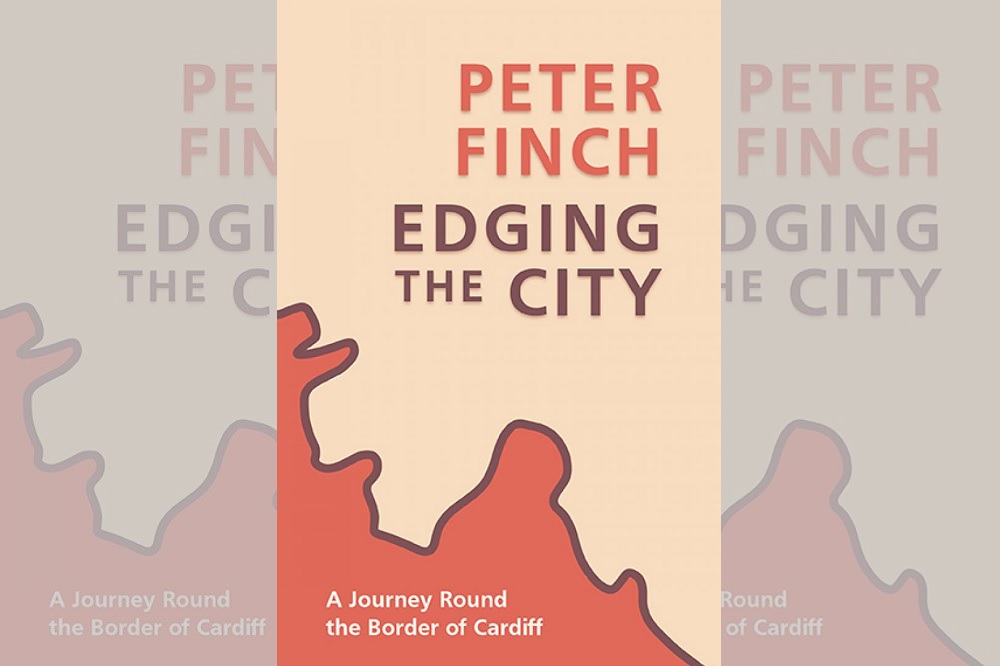Review: Edging the City by Peter Finch

Tim Cooke
Ever since he first encountered Iain Sinclair’s epic circumnavigation of the M25, in 2002’s London Orbital, Cardiff-writer Peter Finch has had something similar in mind for his hometown.
Twenty years on, Edging the City sees the author tracking a far less concrete border in a series of explorations of the outer limits of the Welsh capital.
Pushed into the project by the restrictions imposed during the pandemic, confining citizens to their local authority, he sets about discovering how far the city spreads and where exactly it ends.
In the process, he traverses an array of diverse landscapes, engaging with all sorts of subjects, from border politics to industrial, personal and cultural histories.
Starting at the southernmost point of the Ferry Road peninsula, sitting at a yacht club picnic table, Finch looks out at the water and ponders the city’s edge. ‘Like generations of departing mariners before me,’ he writes, ‘from here I can see the world… Behind me is Wales. A green place again now the dust has ended.’
Extraordinary adventure
It’s the beginning of an extraordinary adventure, and on this first stretch he seems to be setting out his stall.
With eyes fixed on how the past, present and future intertwine, he draws on how this once muddy spit of land and middling market town were transformed by the industrial revolution into a ‘coal port beast’.
With the coal ships now gone, he passes futuristic apartment blocks complete with porthole windows and yacht-sail roofs.
Pollution
Following the Ely north, along its namesake trail, Finch recalls past reasons for the river’s pollution – coal washeries, coke plants, paper mills and sewage – and how it remains prone to flooding.
He treks beside Grangemoor Park and reflects on the strange, terrible beauty of a hump of city refuse ‘capped with a metre of soil with grass on top’, before spotting his first border sign. He comes off the trail at Leckwith Bridge, near Cardiff City Stadium, and gradually shifts his course west.
Among descriptions of one of Henry VIII’s antiquarians and changes to the local topography, he evokes images of Ely Racecourse, which operated from 1855 to 1939, its grandstand burning down in ’37.
Here, he weaves in some interesting family history, via a photo of his great grandfather, looking secure and content – ‘maybe his horse has just won’.
Time and space
The book continues in this way, skipping through mud, mire, time and space. We are taken back to a period of Roman rule and learn about the Victorian-era boom in rifle ranges.
We see the development of the Ely and Caerau housing estates, originally billed together as the Ely Garden Suburb, and there’s a great section on the Caerau Hillfort, which started life as a Neolithic settlement and was fortified in the Iron Age; since then, it has been a burial ground, a medieval farm and, more recently, a spot for downing lager and riding motorbikes.
This is history in motion.
Highlights
Among other rambles, Finch skirts the shopping malls at Culverhouse Cross, takes in the dream-like views of Castell Coch, deviates to Caerphilly Mountain – where his father would drive him on Sunday afternoons in the 60s – and rounds on the modern medieval centre and the Bay again: in all ‘a great lozenge shape.’
Highlights along the track, for me, include his description of a nuclear war monitoring station, the story of the Welsh prince who gave his name to Clwb Ifor Bach (there’s good bit on the Welsh music scene, too) and musings on the politics of rights of way.
There’s a fascinating passage on the Great Flood of 1606, when a five-foot tidal wall killed around two thousand people.
Disused railway lines recur, as do golf courses and examples of anti-vax graffiti scrawled over brick and stone, as if to ground the book in its own time.
Cultural archaeology
It’s fitting, of course, that Finch started with mention of Iain Sinclair, who is clearly a strong influence. I remember reading London Overground in 2015 and thinking of it as an act of cultural archaeology, coming away, as I did, with reams of new names to explore.
Finch’s book does the same thing: he gives a short account, for example, of the brilliant – and influential – literary forger, Iolo Morganwg; he praises the work of naturalist Mary E Gillham, whose trilogy on the Glamorgan heritage coast I’ve already bought; and touches on the life of William Blake’s friend Benjamin Heath Malkin, who took up residence in Cowbridge and whose text The Scenery, Antiquities, and Biography of South Wales sounds essential.
And there’s the music he listens to en route: Robbie Basho, Merle Haggard and Philip Glass, to name just three.
Poetic prose
I’ve read plenty of books in recent years that use walking as a method of connecting with place in a fresh and meaningful way, but few have been situated so close to home.
I’m from Bridgend, went to college in Cardiff and worked briefly on the outskirts of the city – delivering goods to the likes of Celsa, mentioned in the latter stages – so I know some of these locations well, and more in passing.
What Edging the City does so effectively, though, is defamiliarize and enrich these landscapes, with allusion, digression and depth, all painted in seemingly effortless poetic prose.
Finch lifts the apparently mundane to a place of real literary significance, giving some of these lesser-known quarters the attention they deserve.
Edging the City is published by Seren. It is available from all good bookshops or you can buy a copy here.
Support our Nation today
For the price of a cup of coffee a month you can help us create an independent, not-for-profit, national news service for the people of Wales, by the people of Wales.




